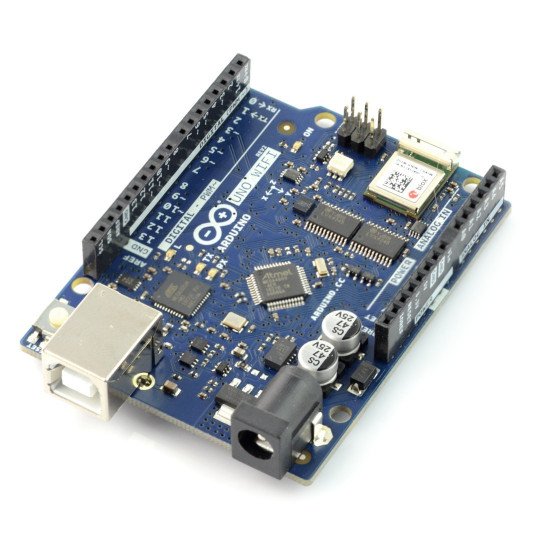- Reduced price
- SPECIAL OFFERS
Description
Popular version of Arduino Uno board with built-in microcontroller AVR ATmega4809and systemU-block W102 for communication with the wi-fi network. ATmage4809 was equipped with14 digital input/outputs, 5of which can be used as outputsPWM(e.g. for motor control), and6 analog inputs. The system works has clock signal frequency of20 MHz, has48 KB Flash program memory,6 KB RAM SRAM, anda 256 B EEPROM. Tile is equipped with a systemIMU(Inertial Measurement Unit) and a cryptographic moduleECC608.
|
Built-in module U-block W102 allows you to access wi-fi and that allows you to create a network of IoT (Internet of Things). Arduino Uno wi-fi can be programmed in the same way as the classical plateArduino Uno |
Key features
Below are a few features that distinguish modules Arduino compared from the other programmable tiles.
| Name | Description |
|---|---|
|
Installed bootloader |
Thanks to bootloader, for programming the device the only necessities are appropriateUSB cableandsoftware from manufacturer's website. |
|
Wi-Fi Module |
Built-in module U-block W102 allows you to access wi-fi and that allows you to create a network of IoT (Internet of Things). |
|
Digital I/O |
14 digital inputs/outputs allow, in particular, to control the LEDs, relays and reading the buttons' states. |
|
Efficiency current |
The maximum load current for one I/O is 20 mA (50 mA output 3.3 V). |
|
Output PWM |
5 outputs PWM allow, for example, to control the motors and brightness of the LEDs. |
|
Analog inputs |
6 inputs of built-in digital-analog converter with a resolution of 10-bit, support, in particular, sensors with analog output. |
|
Serial communication |
The device supports popular communication interfaces, including UART, I2C and SPI. |
| Special functions | Some of the pins have special functions that a brief description is available inour guide. |
|
Built-in memory |
System Atmega4809 has frequency signal with a frequency of 20 MHz and has 48 KB Flash memory, 256 B EEPROM and 6 KB of RAM SRAM. |
|
Supply DC connector |
To power the Arduino, you can useany power supplywith voltage up to 12V with DC connector 5.5 x 2.1 mm. |
|
Supply USB port |
The tile can be powered from a computer via USB cable, bearing in mind that the maximum load current for the USB port is 500 mA. Arduino has a system that protects the socket from short-circuit and the flow of too high current. |
|
Connector ICSP |
The module has ICSP I/O for connecting an externalAVR programmer. |
|
Pin IOREF |
The IOREF Pin provides direct access to the voltage with which output I/O work. |
|
Built-in led |
The connected led on pin 25 allows debugging simple programs. |
|
Output 3.3 V |
Built-in voltage regulator provides power to external devices with the voltage of 3.3 V with current consumption of 50 mA. |
|
First run To help you get started with the module, we recommendthe user manual, which will help you with installation and first launch of the Arduino environment. |
The subject of the sale is the original product for Arduino, Botland isthe official distributor of this company.
Specification
- Supply voltage: 5 V to 12 V
- Microcontroller: ATmega4809
- Maximum clock frequency: 20 MHz
- SRAM: 6 KB
- Flash memory: 48 KB (5 KB is reserved for bootloader)
- EEPROM: 256 B
- Wi-fi module U-block W102:
- I/O Ports: 14
- PWM outputs: 5
- Number of analog inputs: 6 (channels of converter A/C with 10 bit resolution)
- Serial interfaces: UART, SPI, I2C
- External interruptions
- The connected led on pin 25
- USB A connector for programming
- DC connector 5.5 x 2.1 mm for power
- Dimensions: 69 x 53 x 14 mm
- Weight: 25 g
Useful links |
















































































































































































































































































































































